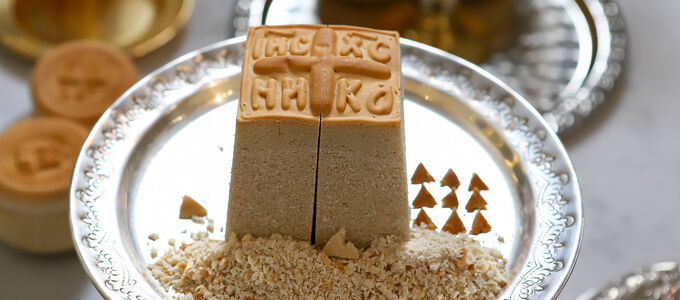
Bread and wine: “This is My” body and blood. For over 2,000 years, Christians have been racking their brains over these words spoken by Jesus at the Last Supper. “Is”—what is that supposed to mean anyway? The answers to this question have been shaped by the mindset of the respective ages.
Why is this even important anyway? It is all about the presence of Jesus Christ in the celebration of Holy Communion. But did He not say that He would be present wherever two or three gathered in His name? Absolutely. However, He also told us what was necessary to eat and drink in order to gain eternal life: here we are talking about the presence of the body and blood of Christ in Holy Communion—a phenomenon known as real presence.
One question, several answers
The Christians of the early centuries did not give too much thought to such questions: they simply celebrated the supper of the Lord. As usual, the turn of the tide was ushered in by Emperor Constantine in the fourth century. It was at that point in history that Christianity developed into the state religion—and gained massive popularity as a result. The many new candidates for baptism were given instruction (catechesis), and this required teaching material.
The Greek Church Fathers found their explanations in the archetype-image scheme of the Greek philosophers. Accordingly, the things of the visible, material world were consubstantial images, or copies, of archetypes from the invisible, true world of the beautiful and the good. And so it was that the archetypes of the body and blood of Christ could easily be present in the images of bread and wine.
The Latin Church Fathers had their own ideas. The most influential of these regarded bread and wine as a sign (signum) of the body and blood, the actual thing (res). This was more than just a symbolic relationship, however: after all, where there is no smoke, there can be no fire. The sign is essentially related to the actual thing.
Dispute about either/or
For some 400 years, the matter remained fundamentally unresolved. And the church tolerated these differing answers. This changed in the eighth century, as Christianity began to spread among the Germanic peoples and the Franks. They did not know what to make of the complex understanding of reality that was so characteristic of the ancient Greeks.
The new way of thinking only allowed for an either/or scheme: either it was an image or a thing, either symbol or reality. And this polarisation led to disputes. From then on, interpretations fluctuated between the substantial/material and the symbolic/spiritual.
These arguments reached their zenith in two major disputes about the Lord’s Supper: in the ninth century, the abbot of a Franconian monastery and one of his monks clashed in public. And in the eleventh century, the headmaster of the cathedral school of Tours took on various synods. At the end, he was obliged to swear that the teeth of the believers were chewing on the body of Christ—which he found absurd.
Back to the Greeks
The end of the bickering came when the Scholastics rediscovered the ancient Greek philosophers on the eve of the Renaissance. It was there that the explanatory model of substance and accidence—of content and shape—was found. At that time, substance did not refer to chemical matter, as the word is usually understood today, but rather the innermost essence of a thing. And accordingly, accidence referred to its material properties.
Applied to the phenomenon of real presence, the following train of thought results: bread and wine retain their accidence—that is, their outward form and material properties. However, their substance—their inner content, their true nature—changes. Thus the body and blood of Christ are not materially present, but are truly present in their essence. Theologians refer to this concept as transubstantiation.
For around 200 years, this concept brought the church some peace. However, new conflicts arose with the Reformers. More on this in the next issue of this series.
Photo: Igor Mojzes














